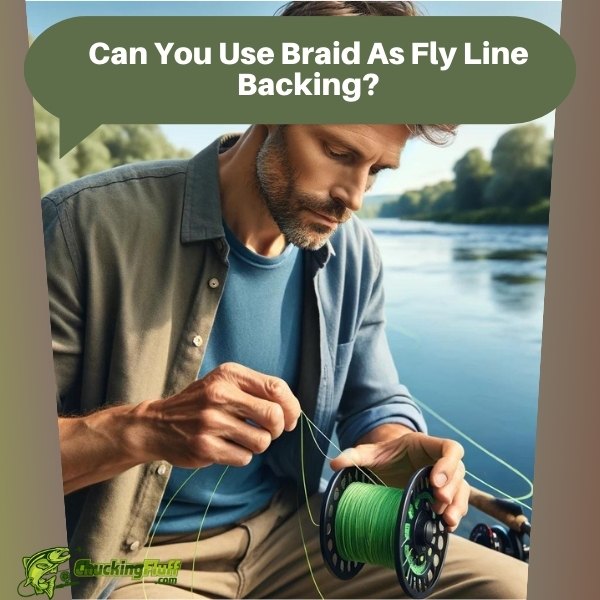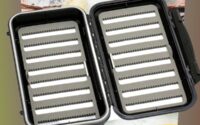| Disclosure: Just to be open and honest the buttons and links you click on in the website will in most cases take you to another website where you can purchase the products I am reviewing. As an Amazon Associate I earn from qualifying purchases. |
Can You Use Braid As Fly Line Backing? Bulk up that Reel
Quick Post Navigation
Introduction to Fly Fishing Line Components
Overview of Fly Line, Backing, and Leader
Fly fishing setups involve a delicate balance of three main line components: the fly line, the backing, and the leader. Each plays a critical role in successful fishing. The fly line delivers the fly to the target with precision, the backing ensures there is enough line for long runs by fish, and the leader connects the fly line to the fly, presenting it naturally.
The Role of Backing in Fly Fishing
Backing is more than just filler material for your reel; it’s a crucial component that provides additional line length for fighting fish, especially when they make long, powerful runs. Backing fills up the spool, allowing the fly line to be retrieved and let out smoothly, which is essential for maintaining an even drag and effective line management during a catch.
Understanding Braid Line
What is Braid Line?
Braided line is crafted from multiple strands of synthetic materials such as Dacron, or Dyneema, interwoven to create a strong, durable line. It is renowned for its fine diameter and exceptional strength, making it a popular choice for many types of fishing.
- Rio's traditional Dacron braided backing features high strength and low stretch and is unsurpassed in quality
- A good compromise between thinness and the ability to make blind
- It's easier to knot than other brands that are very thin but have too tight a weave for a blind Splice loop
Advantages of Using Braid Line
One of the key benefits of braid is its high strength relative to its diameter, which allows more line to be spooled onto the reel without increasing its size or weight. This characteristic also reduces water drag, facilitating quicker and deeper sinking when needed and improving lure presentation.
Potential Drawbacks of Braid for Backing
Despite its advantages, braid has its drawbacks when used as fly line backing. Its smooth texture can lead to slippage on the reel spool unless properly secured. Additionally, without proper care, braid can wear at the contact points on the reel, potentially reducing its lifespan.
Comparing Braid with Traditional Fly Line Backing
Durability and Strength
Braid generally surpasses traditional materials like nylon in both durability and strength, which can be crucial during encounters with large fish. Its robust nature means it can withstand the intense pressures of battling big fish over extended periods.
Diameter and Capacity
Braid’s thinner profile allows for significantly more line on the spool, which is vital when targeting species known for long runs. This increased capacity can be the difference between landing a big fish and losing it.
Knot Strength and Compatibility
Because of its slick, woven structure, braid requires carefully chosen knots to ensure secure connections. This section would cover the best practices for tying braid to ensure it holds firm under the strain of a catch.
Practical Insights
When to Consider Braid for Backing
Braid is particularly advantageous in scenarios where reel space is at a premium or when targeting fast-running species. Its higher capacity and lower drag make it ideal for such situations.
Tips for Spooling Braid as Backing
Spooling braid correctly is vital to prevent slippage and ensure optimal performance. Techniques such as using a mono backing layer or taping the braid to the spool can help achieve a secure setup.
Handling and Maintenance Tips
Regular maintenance is crucial to maximizing the effectiveness and lifespan of braid backing. Proper storage, regular cleaning after exposure to saltwater, and routine checks for wear and tear are recommended practices.
Expert Opinions
What Professionals Say
Many seasoned anglers and guides advocate for the use of braid as backing due to its superior properties. They highlight its reliability in challenging conditions and its ability to handle powerful fish.
Case Studies or Examples
This section would feature anecdotal evidence and specific cases where anglers have benefited significantly from switching to braid for their backing, illustrating its effectiveness in real-world scenarios.
Pros and Cons
Benefits Summarized
A summary of braid’s benefits such as increased reel capacity, reduced drag, superior strength, and longevity, making it a top choice for many anglers.
Limitations to Consider
It’s also important to acknowledge potential downsides like the need for specialized knots, the possibility of slippage, and the initial higher cost compared to traditional backing materials.
Conclusion
Final Thoughts
After weighing the benefits and challenges, the suitability of braid as fly line backing often depends on the specific circumstances of the fishing environment and the angler’s preferences.
Recommendations for Anglers
Advice on selecting the right backing material is tailored to the angler’s typical fishing environments, target species, and personal preferences, ensuring the best possible performance from their gear.
FAQs
Q) Can braid damage my fly reel?
A) Braid line itself typically does not damage fly reels if used properly. However, due to its thin and sometimes abrasive nature, it can potentially wear on the reel’s spool, especially at the points of contact under high tension. To mitigate this, ensure that your reel is compatible with braid and consider using a reel with a ceramic or otherwise hardened line guide and a robust spool design. Regularly check and maintain your equipment to prevent any damage.
Q) How much braid should I use for backing?
A) The amount of braid you should use depends on a few factors, including the size of your reel and the type of fishing you plan to do. Generally, for smaller freshwater fishing scenarios, 100 to 150 yards of braid is sufficient. For larger saltwater game, you may need 200 to 300 yards or more to handle longer runs. Braid’s thinner diameter compared to traditional materials like Dacron allows for more line on the reel, which is beneficial for chasing species that make long, fast runs.
Q) Can I mix braid with other types of backing?
A) Mixing braid with other types of backing is technically possible but not generally recommended. Braid and traditional materials like Dacron differ significantly in stretch and texture, which can lead to uneven winding and potential slippage under load. If you must mix backing types, ensure a seamless connection with proper knots and consider the transition’s impact on the overall capacity and performance of your reel.
Q) What are the cost implications of using braid?
A) Braid can be more expensive than traditional Dacron backing, but the price is often justified by its advantages. Braid’s superior strength and lower diameter mean you can have more backing on your reel, which is crucial for large game fishing. It’s also more durable, which might reduce the frequency of replacements. When considering the cost, weigh these benefits against your specific fishing needs to determine if the investment is worthwhile.
Q) How does braid perform in saltwater environments?
A) Braid performs exceptionally well in saltwater due to its resistance to rot and UV damage. Its lack of stretch and high sensitivity also allow for better hook sets and more direct control over the line. However, salt can be abrasive and may impact the longevity of braid if not rinsed off after use. Always thoroughly clean and dry your braid backing after exposure to saltwater to maintain its performance and durability.
These detailed answers aim to address common concerns and provide practical advice for anglers considering using braid as fly line backing.
“Check out some of our other Buying Guides”
Last update on 2025-06-19 / Affiliate links / Images from Amazon Product Advertising API
This product presentation was made with AAWP plugin.




